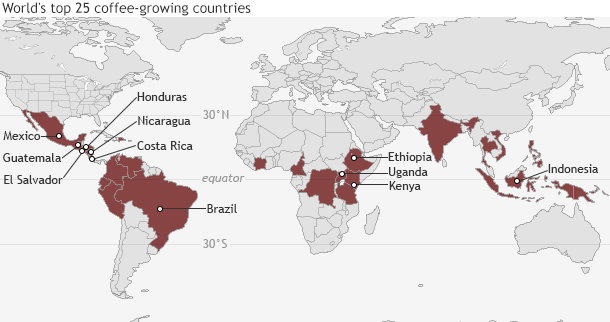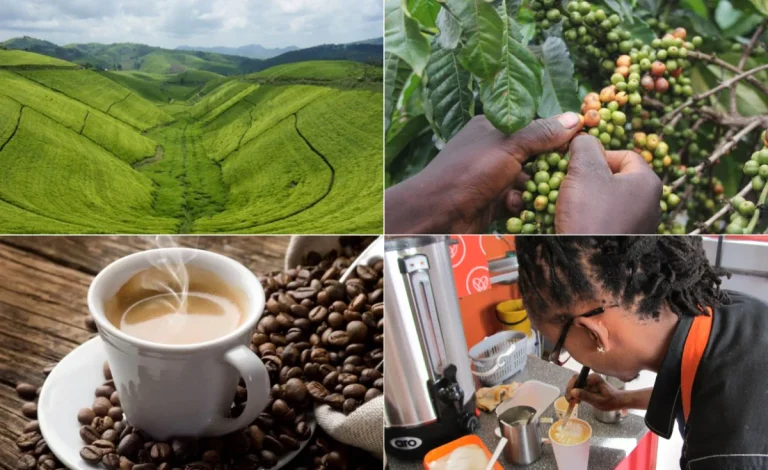Coffee production is a vital industry that impacts economies and cultures worldwide.
We will explore the top coffee-producing countries and delve into the significance of coffee cultivation.
From the vast plantations of Brazil to the high-altitude farms of Ethiopia, each country offers a unique perspective on the global coffee industry.
By analyzing production volumes and key factors influencing output, we aim to provide a comprehensive overview of the leaders in coffee cultivation.
Join us as we uncover the future trends shaping the world of coffee production.
Key Takeaways:
- Brazil is the top coffee-producing country, with over 2.6 million metric tons of production annually.
- Vietnam and Colombia follow closely behind, producing over 1.5 and 0.75 million metric tons respectively.
- The factors influencing coffee production include climate, government policies, and consumer demand, making it a complex and dynamic industry.
Introduction to Coffee Production
Coffee production is a vital aspect of the global economy, with numerous countries contributing to the cultivation of this beloved beverage. The process of growing and harvesting coffee beans involves a combination of expertise, climate considerations, and agricultural practices.
The quality and taste of coffee are heavily influenced by the region in which it is grown. Different regions, such as Africa, Central America, South America, and Asia, each have their unique coffee-growing conditions, resulting in distinct flavor profiles. For instance, Ethiopian coffee is renowned for its floral and citrus notes, while Colombian coffee is celebrated for its smooth and balanced taste.
Understanding the Global Coffee Industry
The global coffee industry encompasses a complex network of producers, distributors, and consumers, with key players including Brazil, Vietnam, and Colombia. These countries are renowned for their diverse coffee beans, such as Arabica and Robusta, which are grown in unique climates across Africa and Indonesia.
In Brazil, the largest coffee producer globally, the rich volcanic soil and favorable climate provide ideal conditions for cultivating the sought-after Arabica beans.
Vietnam, known for its Robusta beans, has seen a significant rise in production, becoming a key player in the global market.
Colombia, with its high-altitude coffee plantations, produces some of the finest Arabica beans, prized for their smooth, mild flavor.
African countries like Ethiopia and Kenya are recognized for their specialty coffee varieties, contributing unique flavors to the industry.
Indonesia, including regions like Sumatra and Java, cultivates distinct Robusta beans known for their bold and earthy profiles.
Significance of Coffee Cultivation
Coffee cultivation holds immense cultural and economic significance for countries like Guatemala, Honduras, and India, where the rich coffee heritage has become intertwined with the national identity. The unique flavors and aromas of coffee from these regions reflect the diverse growing conditions and farming practices employed by local producers.
The coffee culture in Guatemala is deeply rooted in its history, with sprawling coffee plantations dotting its lush landscapes. In Honduras, coffee plays a vital role in the livelihoods of many rural communities, fostering a strong sense of community and connection among farmers. India, on the other hand, boasts a long tradition of coffee cultivation in the picturesque hills of Coorg and Chikmagalur, where the coffee estates showcase a harmonious blend of nature and human ingenuity.
Top Coffee-Producing Countries
Regarding coffee production, several countries stand out as the top contributors to the global market. Brazil, Vietnam, Colombia, Ethiopia, and Indonesia consistently rank among the top coffee-producing nations, showcasing their expertise and dedication to the cultivation of this beloved beverage.
Brazil, often hailed as the world’s largest coffee producer, plays a significant role in shaping the coffee industry. With its diverse landscape and favorable climate, Brazil produces a wide variety of coffee beans, including the renowned Arabica and Robusta varieties.
Vietnam, on the other hand, is known for its robust Robusta beans, making it one of the top Robusta producers globally. Colombia stands out for its high-quality Arabica beans, with the region’s ideal altitude and climate contributing to its distinctive flavor profile.
Moving to Ethiopia, the birthplace of coffee, this country boasts a rich coffee heritage, producing some of the most unique and flavorful Arabica beans. Ethiopian coffee is celebrated for its floral and fruity notes, setting it apart in the specialty coffee market. Indonesia, with its diverse array of islands, is famous for its premium Sumatran and Java coffees.
The unique processing methods, such as wet-hulling in Sumatra, contribute to the bold flavors and earthy undertones of Indonesian coffee.
Overview of the Top 10 Coffee-Producing Countries
The top 10 coffee-producing countries boast a diverse range of coffee beans known for their quality and distinct flavors. From sprawling coffee farms in Africa to lush growing regions with ideal climates, these nations play a crucial role in satisfying the global demand for premium coffee products.
Each country contributes its unique touch to the global coffee industry. For instance, Brazil, the largest coffee producer, is renowned for its rich, full-bodied beans with notes of chocolate and nuts. Colombia, on the other hand, stands out for its balanced and mild Arabica beans, often characterized by fruity and floral undertones.
Regions like Ethiopia and Kenya showcase the vibrant and complex profiles of African coffee, featuring bright acidity and floral aromas. Meanwhile, countries like Vietnam excel in producing robusta beans known for their strong, bitter flavor.
The high altitudes of coffee farms in regions like Guatemala and Costa Rica result in beans with bright acidity and unique fruity notes. On the other hand, Indonesian coffees, such as those from Sumatra, offer earthy and spicy flavors with a heavy body.
Exploring the Rankings
As we delve deeper into the rankings of coffee-producing countries, the unique contributions of Guatemala, Honduras, and India emerge as key players in the global coffee industry. Their rich coffee heritage and dedication to sustainable farming practices have positioned them as leaders in the cultivation of premium coffee beans.
Guatemala, known for its high-quality Arabica beans, boasts a complex flavor profile with hints of chocolate and fruitiness. This Central American country’s coffee production is renowned for its strict adherence to shade-grown methods, ensuring environmental conservation.
Honduras, on the other hand, excels in producing mild and well-balanced beans, appreciated for their smooth acidity and sweet undertones, making it a favorite among specialty coffee enthusiasts.
Meanwhile, India, with its robusta and arabica blends, offers a diverse array of flavor profiles influenced by its unique microclimates. From the spicy notes of Indian Monsooned Malabar to the floral aromas of Karnataka beans, Indian coffee varieties are known for their versatility and depth of taste.
Uganda – 209,325 Metric Tons
Uganda is a significant contributor to the global coffee market, producing an impressive volume of coffee beans each year. The country’s coffee industry plays a vital role in supporting its economy and providing employment opportunities to numerous farmers.
Uganda’s favorable climate and rich soil make it an ideal location for coffee cultivation. The country’s annual coffee bean production hovers around 5 million 60-kilogram bags, with Arabica and Robusta being the dominant varieties grown. This significant output positions Uganda as one of Africa’s top coffee producers. The economic impact of this industry is substantial, with coffee exports generating crucial revenue for the country. Coffee cultivation provides livelihoods for countless locals, contributing to rural development and sustainable agriculture practices.
Guatemala – 245,441 Metric Tons
Guatemala stands out as a premier coffee producer, known for its exceptional Arabica beans cultivated on picturesque farms across the region. The coffee industry in Guatemala thrives on a legacy of quality and sustainability, making it a sought-after source of premium coffee products.
The lush landscapes of Guatemala play host to sprawling coffee farms, where farmers meticulously tend to each Arabica coffee tree to ensure the beans reach their peak flavor potential. These farms, nestled amidst verdant hills and volcanic terrain, create a stunning backdrop for coffee cultivation.
Guatemala’s commitment to producing high-quality coffee extends beyond just the growing process; the industry as a whole prioritizes sustainable practices, from eco-friendly farming methods to fair labor practices for workers. This dedication to sustainability not only benefits the environment but also ensures the long-term viability of the coffee industry in Guatemala.
India – 234,000 Metric Tons
India’s coffee industry has grown steadily over the years, with a focus on Robusta beans that thrive in the country’s unique climate. The flavors and aromas of Indian coffee reflect the diverse growing regions and farming traditions that have defined the nation’s coffee culture.
Robusta coffee, known for its strong and bold flavor profile, is predominantly cultivated in the southern regions of India, such as Karnataka, Kerala, and Tamil Nadu. These areas provide ideal conditions for Robusta beans, including the right altitude, rainfall, and temperature. The coastal regions of India also play a crucial role in coffee production, contributing to the unique taste profiles of Indian coffee.
Coffee farming in India holds cultural significance, with many farms being family-owned for generations, passing down traditional knowledge and sustainable practices. The meticulous care taken in growing, harvesting, and processing coffee beans reflects the deep-rooted connection between coffee cultivation and local traditions.
Peru – 346,466 Metric Tons
Peru has established itself as a top producer of high-quality Arabica coffee, renowned for its rich flavors and smooth profiles. The coffee industry in Peru thrives on the commitment to excellence and sustainability, making it a favored source of premium coffee beans.
Within the lush landscapes of Peru, coffee cultivation is not just a practice but a tradition woven into the fabric of the nation’s identity. The fertile soils and unique microclimates provide the perfect conditions for Arabica coffee to flourish, resulting in beans that possess a refined sweetness and vibrant acidity. This delicate balance of flavors is what sets Peruvian coffee apart, with notes of caramel, citrus, and floral undertones captivating coffee connoisseurs worldwide.
Ethiopia – 471,247 Metric Tons
Ethiopia is celebrated as the birthplace of coffee, with a rich heritage of Arabica beans that grow in the highlands of this African nation. The coffee culture in Ethiopia is deeply intertwined with tradition and history, making it a cornerstone of the country’s identity.
With over a thousand years of coffee cultivation, Ethiopia has mastered the art of coffee production, contributing significantly to its status as a coffee pioneer. The unique growing conditions, characterized by high altitudes, fertile soil, and ideal climate, play a vital role in shaping the exceptional flavors of Ethiopian coffee.
More than just a beverage, coffee holds a sacred place in Ethiopian society, often involved in social gatherings, ceremonies, and daily rituals. The traditional Ethiopian coffee ceremony, known as ‘Buna’, is a symbol of hospitality and community unity, reflecting the deep-rooted cultural significance of coffee in the country.
Honduras – 475,042 Metric Tons
Honduras has emerged as a key player in the coffee industry, known for its high-quality Arabica beans produced on thriving coffee farms across the country. The coffee sector in Honduras has experienced significant growth, bolstering the nation’s economy and global reputation as a coffee powerhouse.
The rich volcanic soil and diverse microclimates in Honduras provide ideal conditions for cultivating Arabica beans, favored for their nuanced flavors and higher quality compared to other coffee varieties. These beans are prized for their smooth, vibrant taste with hints of chocolate and citrus notes, making them highly sought after by coffee connoisseurs worldwide.
Driven by a strong tradition of coffee farming, Honduran coffee producers employ sustainable practices that not only ensure superior bean quality but also promote environmental conservation. This commitment to ethical and environmentally friendly production methods has garnered international acclaim and further elevated Honduras’ standing in the global coffee market.
Indonesia – 668,677 Metric Tons
Indonesia is renowned for its rich coffee heritage and the production of high-quality Robusta beans that thrive in the country’s diverse landscapes. The coffee industry in Indonesia blends tradition with modern practices, creating a unique coffee experience for connoisseurs worldwide.
Robusta coffee beans from Indonesia are known for their bold flavor profile, which includes earthy notes and a deep, rich body that sets them apart in the global market. The volcanic soil in regions like Sumatra and Java imparts a distinctive taste to the beans, contributing to their sought-after quality. Indonesia’s coffee landscapes range from lush mountainsides to tropical rainforests, offering a variety of microclimates ideal for cultivating different coffee varieties.
Colombia – 754,376 Metric Tons
Colombia is a global coffee powerhouse, known for its exceptional Arabica beans that flourish in the country’s mountainous regions. The coffee culture in Colombia is deeply ingrained in the national identity, with a focus on quality, sustainability, and innovation.
The unique geography of Colombia, with its high altitudes, rich volcanic soil, ample rainfall, and well-defined seasons, provides ideal conditions for growing these prized Arabica beans. The country’s microclimates, varying from region to region, contribute to the diverse flavor profiles found in Colombian coffee, ranging from fruity and floral to nutty and chocolatey.
Over the years, Colombia has established itself as a prominent player in the coffee industry, renowned for its strict quality control measures, cooperative growing practices, and commitment to environmentally friendly production methods. The evolution of Colombia’s coffee sector highlights a transition towards specialty coffees, direct trade relationships, and a focus on elevating the entire coffee supply chain.
Vietnam – 1,542,398 Metric Tons
Vietnam has emerged as a major player in the coffee industry, renowned for its robust Robusta beans that thrive in the country’s favorable climate. The coffee sector in Vietnam has seen remarkable growth, shaping the nation’s agricultural landscape and economic development.
In recent decades, Vietnam’s coffee production has soared, with the country now being the second-largest coffee producer in the world, following closely behind Brazil. The ideal climate, with its combination of ample rainfall, moderate temperatures, and fertile soil, provides the perfect conditions for cultivating high-quality coffee beans.
Robusta beans dominate the Vietnamese coffee market, accounting for around 95% of the country’s coffee exports. These beans are known for their strong flavor profile and high caffeine content, making them a popular choice for espresso blends and instant coffee.
The significant role of coffee production in Vietnam’s economy cannot be understated, as it provides employment opportunities for hundreds of thousands of people and contributes significantly to the nation’s GDP. The growth of the coffee industry has led to increased investment in infrastructure and technology, further bolstering Vietnam’s position as a key player in the global coffee market.
Brazil – 2,680,515 Metric Tons
Brazil stands out as the largest producer of coffee in the world, renowned for its flavorful Arabica beans grown across vast plantations in different regions. The coffee industry in Brazil has a rich history and a global reputation for quality and innovation.
The dominance of Brazilian coffee can be attributed to its ideal climate and terrain, providing the perfect conditions for cultivating high-quality Arabica beans. In Brazil, coffee plantations range from the rolling hills of Minas Gerais to the lush landscapes of Sao Paulo, each contributing unique flavor profiles to the country’s diverse coffee offerings.
These plantations not only showcase the sheer scale of Brazil’s coffee production but also reflect the cultural significance of coffee in Brazilian society. With a long tradition of coffee cultivation, Brazil has honed its expertise in coffee farming and processing techniques over generations.
Comparison of Coffee Production
A comparative analysis of coffee production among key countries like Brazil, Vietnam, Colombia, Ethiopia, and Indonesia reveals unique strengths and challenges in each region. Understanding the factors influencing coffee cultivation in these nations can provide valuable insights into the global coffee industry.
Brazil, the largest coffee producer in the world, is known for its vast plantations primarily in the regions of Minas Gerais and Sao Paulo. The country benefits from a favorable climate, suitable altitudes, and a well-established infrastructure for coffee processing, making it a key player in the coffee market.
Vietnam, on the other hand, has emerged as a significant coffee producer due to its robusta coffee cultivation. The country faces challenges related to sustainability practices and maintaining quality standards amidst increasing competition.
Colombia, celebrated for its high-quality Arabica beans, maintains a strong reputation in the specialty coffee sector. Issues such as fluctuating weather patterns and the impact of pests and diseases pose continuous challenges to its coffee production.
Analyzing the Leading Coffee Producers
An in-depth analysis of the leading coffee producers sheds light on the quality standards, farming practices, and environmental considerations that shape the global coffee industry. From the lush farms of Africa to the diverse growing regions worldwide, these producers set benchmarks for excellence in coffee cultivation.
These coffee producers undertake meticulous processes to ensure the highest quality beans reach coffee lovers’ cups. African farms, known for their rich soils and optimal growing conditions, play a pivotal role in producing exquisite coffee beans renowned for their distinct flavors.
The unique microclimates in different regions also influence the taste profiles of the beans, with factors like altitude, rainfall, and temperature intricately connected to the final flavor notes found in a cup of coffee.
Factors Influencing Production Volumes
Various factors play a significant role in determining the production volumes of major coffee-producing countries like Brazil, Vietnam, Colombia, Ethiopia, and Indonesia. Climate conditions, farming techniques, and market dynamics all contribute to the success and challenges faced by these nations in meeting global coffee demand.
Climate plays a crucial role in coffee cultivation; a delicate balance of temperature, rainfall, and altitude is essential for optimal growth. Regions closer to the equator often provide ideal conditions for coffee plants.
In terms of farming techniques, traditional methods such as shade-grown coffee or organic farming are prevalent in countries like Ethiopia and Colombia, while modern techniques involving machinery and processing technology are employed in Brazil and Vietnam.
Market trends, such as fluctuating prices and evolving consumer preferences, impact the choices made by coffee producers and can influence production decisions. These factors collectively shape the supply of coffee in the global market.
Conclusion
The global coffee industry is a dynamic landscape shaped by the contributions of key players like Brazil, Vietnam, Colombia, Ethiopia, and Indonesia. Their dedication to quality, sustainability, and innovation continues to drive the growth and evolution of the coffee market worldwide.
These countries have made significant strides in improving the quality of their coffee beans, implementing sustainable farming practices, and fostering a culture of innovation in coffee production. Brazil, known for its flavorful and aromatic Arabica beans, remains the largest coffee producer globally, setting high standards for others in terms of quality assurance and flavor profiles. Vietnam, with its robust Robusta beans, has emerged as a key player in the industry, focusing on sustainable farming methods and technological advancements to enhance productivity.
Colombia’s commitment to producing high-quality Arabica beans through stringent regulations and certifications has earned it a reputation for premium coffee around the world. Ethiopia, the birthplace of coffee, continues to influence the market with its unique and diverse coffee varieties, promoting sustainable practices and fair trade initiatives.
Indonesia, renowned for its rich, full-bodied Sumatran and Java coffees, has been at the forefront of introducing innovative processing methods and exotic flavor profiles. Looking ahead, the future of the coffee market is likely to be shaped by increasing consumer demand for ethically sourced, environmentally friendly coffee, driving producers to further prioritize sustainability and quality in their practices.
Summary of the Global Leaders in Coffee Cultivation
The global leaders in coffee cultivation, such as Brazil, Vietnam, Colombia, Ethiopia, and Indonesia, represent the pinnacle of excellence in the industry. Their distinct contributions to the coffee market underscore the richness and diversity of the global coffee landscape, setting benchmarks for quality and innovation.
These countries have significantly shaped the coffee industry through their unique strengths and innovations.
- Brazil stands out as the largest coffee producer worldwide, renowned for its high-quality Arabica beans.
- Vietnam has made a mark with its robusta beans, becoming the second-largest coffee exporter globally.
- Colombia is celebrated for its superior arabica coffee and emphasis on sustainable farming practices.
- Ethiopia boasts a rich coffee heritage, being the birthplace of coffee and producing diverse flavor profiles.
- Indonesia has gained recognition for its distinctive and sought-after Sumatran and Java coffees.
Future Trends in Coffee Production
The future of coffee production holds exciting possibilities, with a focus on enhancing quality, sustainability, and diversity. As emerging trends in Arabica and Robusta cultivation, innovative farming practices, and the role of African farms shape the industry, the global coffee market is poised for transformation and growth.
Advancements in coffee production are not limited to just increasing yields; the emphasis now extends to promoting sustainability and enhancing the quality of the coffee beans. Quality remains a key driver in consumer preferences, driving producers to adopt more sustainable practices that can positively impact both the environment and the flavor profile of the coffee. This shift towards more environmentally friendly and socially responsible cultivation methods is not only beneficial for the industry but also aligns with the growing global demand for ethically sourced products.
Frequently Asked Questions
What are the top coffee-producing countries in the world?
The top coffee-producing countries in the world are Brazil, Vietnam, Colombia, Indonesia, and Ethiopia. They account for over 50% of global coffee production.
What makes these countries the global leaders in coffee cultivation?
These countries have ideal growing conditions for coffee, including favorable climate, soil, and altitude. They also have a long history and tradition of coffee production, as well as advanced technology and infrastructure.
Which country produces the most coffee in the world?
Brazil is the top coffee-producing country in the world, accounting for approximately 40% of global coffee production.
What are the main types of coffee grown in these countries?
The main types of coffee grown in these countries are Arabica and Robusta. Arabica is known for its high quality and flavorful taste, while Robusta is more commonly used in blends and instant coffee.
Do these countries also consume a lot of coffee?
Yes, many of these top coffee-producing countries also have a high coffee consumption per capita. Brazil, for example, is both the top producer and consumer of coffee in the world.
Are there any other countries that are becoming major players in coffee production?
Yes, countries such as Honduras, India, and Uganda are also increasing their coffee production and are becoming major players in the global coffee market.






